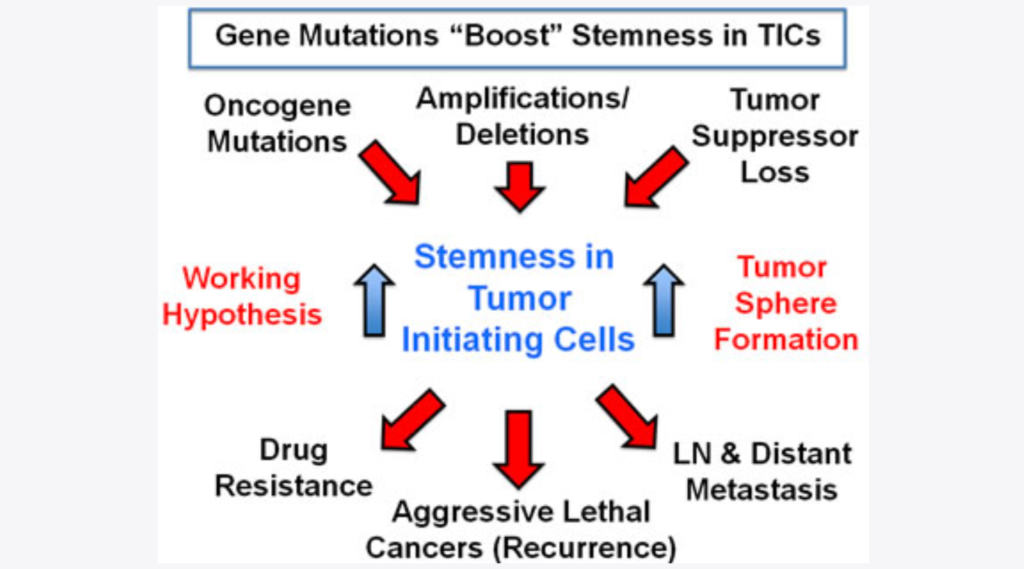In 2014, an eight-year-old child’s comment fueled a strategy to eradicate cancer cells using antibiotics, which was tested by targeting the mitochondria of cancer stem cells across multiple tumor types.

The Top-Performer series highlights research literature published in Oncotarget that has generated a high Altmetric score. Altmetric scores, located at the top-left of trending Oncotarget papers, provide an at-a-glance indication of the volume and type of online attention the research has received. Read Oncotarget’s Top 100 Altmetric papers.
—
In the United Kingdom, circa 2014, husband and wife cancer research team Michael Lisanti and Federica Sotgia—practicing at the University of Manchester at the time—were discussing work at the dinner table with their daughter, Camilla. Camilla was eight years-old and attended Moor Allerton Preparatory School. Michael engaged his daughter in their conversation and playfully asked her how she would go about curing cancer. Camilla thought for a moment and, just as a true scientists’ daughter might, she said that she would simply use antibiotics to cure cancer. “Like when I have a sore throat,” she explained.
While some might have quickly dismissed their child’s comment, Michael and Federica decided to sincerely consider the idea of using antibiotics to eradicate cancer across multiple cancer types. They gathered a small team of interested researchers from the University of Manchester, Albert Einstein College of Medicine, and the Sidney Kimmel Cancer Center, based out of the United Kingdom’s Manchester and the United States’ New York and Philadelphia, respectively.
In 2015, the team successfully published a highly-rated paper about their study in the open-access journal Oncotarget, titled, “Antibiotics that target mitochondria effectively eradicate cancer stem cells, across multiple tumor types: Treating cancer like an infectious disease.” This paper currently presents with an Altmetric Attention score of 167 and a Dimensions score of 260.
The Study
The researchers explained that their strategy was to find commonalities between different tumor types, rather than to try to focus on targeting the differences between cancer types. Their goal was to get to the root of the cancer problem, and not to attempt to treat various mutations in different cancer types. They found that one common underlying potential target was in cancer stem cells and their stemness (ability to replicate and potential to differentiate into other cell types in the tumor).
“We searched for a global phenotypic characteristic that was highly conserved among cancer stem cells, across multiple tumor types, to provide a mutation-independent approach to cancer therapy.”
The researchers identified the phenotypic “weak point” or “Achilles’ heel,” as the cancer stem cells’ strict dependence on the growth and division of the mitochondria. Mitochondrial biogenesis allows for the anchorage-independent clonal expansion and survival of the cancer stem cell population. The researchers then identified several classes of FDA-approved antibiotics that inhibit mitochondrial biogenesis. Interestingly, mitochondrial inhibition from these antibiotics were listed as side-effects by the drug developers, but the researchers in this study used the mitochondrial inhibition of these antibiotics as desired therapeutic effects.
“Here, we show that 4-to-5 different classes of FDA-approved antibiotics, which inhibit mitochondrial biogenesis as an “off-target” effect, can be used to eradicate cancer stem cells, in 12 different cancer cell lines, across 8 different tumor types (breast, DCIS, ovarian, prostate, lung, pancreatic, melanoma, and glioblastoma (brain)).”
Results & Conclusion
“This new therapeutic strategy takes advantage of the manageable side-effects of these antibiotics, which affect eukaryotic mitochondria, although these compounds are currently used for the broad-spectrum treatment of bacterial and parasitic infectious diseases.”
The researchers found that these 4-5 antibiotics converge to inhibit three main mitochondrial targets (summarized above): azithromycin, doxycycline, tigecycline, chloramphenicol, and the anti-parasitic drug pyrvinium pamoate. These drugs effectively inhibited tumor-sphere formation in 10 different cancer cell lines—warranting further clinical study of this method of using antibiotics to target epithelial mitochondria to treat cancer like an infectious disease.
Since the publication of this paper, many other studies and reviews pertaining to the topic of antibiotic use in cancer therapies have emerged, including “FOXM1 in sarcoma: role in cell cycle, pluripotency genes and stem cell pathways,” “Dietary capsaicin and antibiotics act synergistically to reduce non-alcoholic fatty liver disease induced by high fat diet in mice,” “The impact of antibiotic usage on the efficacy of chemoimmunotherapy is contingent on the source of tumor-reactive T cells,” “Impact of antibiotic treatment on immune-checkpoint blockade efficacy in advanced non-squamous non-small cell lung cancer,” and many others.
Click here to read the full scientific paper, published in Oncotarget.
—
Oncotarget is a unique platform designed to house scientific studies in a journal format that is available for anyone to read—without a paywall making access more difficult. This means information that has the potential to benefit our societies from the inside out can be shared with friends, neighbors, colleagues and other researchers, far and wide.
For media inquiries, please contact media@impactjournals.com.



